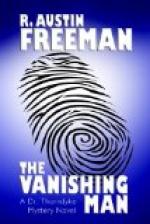We halted before the plain coffer of stone, weathered and wasted by age, but yet kept in decent repair by some pious hands, and read the inscription, setting forth with modest pride, that here reposed Anna, sixth daughter of Richard Cromwell, “The Protector.” It was a simple monument and commonplace enough, with the crude severity of the ascetic age to which it belonged. But still, it carried the mind back to those stirring times when the leafy shades of Gray’s Inn Lane must have resounded with the clank of weapons and the tramp of armed men; when this bald recreation-ground was a rustic churchyard, standing amidst green fields and hedgerows, and countrymen leading their pack-horses into London through the Lane would stop to look in over the wooden gate.
Miss Bellingham looked at me critically as I stood thus reflecting, and presently remarked, “I think you and I have a good many mental habits in common.”
I looked up inquiringly, and she continued: “I notice that an old tombstone seems to set you meditating. So it does me. When I look at an ancient monument, and especially an old headstone, I find myself almost unconsciously retracing the years to the date that is written on the stone. Why do you think that is? Why should a monument be so stimulating to the imagination? And why should a common headstone be more so than any other?”
“I suppose it is,” I answered reflectively, “that a churchyard monument is a peculiarly personal thing and appertains in a peculiar way to a particular time. And the circumstance that it has stood untouched by the passing years while everything around has changed, helps the imagination to span the interval. And the common headstone, the memorial of some dead and gone farmer or labourer who lived and died in the village hard by, is still more intimate and suggestive. The rustic, childish sculpture of the village mason and the artless doggerel of the village schoolmaster, bring back the time and place and the conditions of life much more vividly than the more scholarly inscriptions and the more artistic enrichments of monuments of greater pretensions. But where are your own family tombstones?”
“They are over in that farther corner. There is an intelligent, but inopportune, person apparently copying the epitaphs. I wish he would go away. I want to show them to you.”
I now noticed, for the first time, an individual engaged, note-book in hand, in making a careful survey of a group of old headstones. Evidently he was making a copy of the inscriptions, for not only was he poring attentively over the writing on the face of the stone, but now and again he helped out his vision by running his fingers over the worn lettering.
“That is my grandfather’s tombstone that he is copying now,” said Miss Bellingham; and even as she spoke, the man turned and directed a searching glance at us with a pair of keen, spectacled eyes.
Simultaneously we uttered an exclamation of surprise; for the investigator was Mr. Jellicoe.




